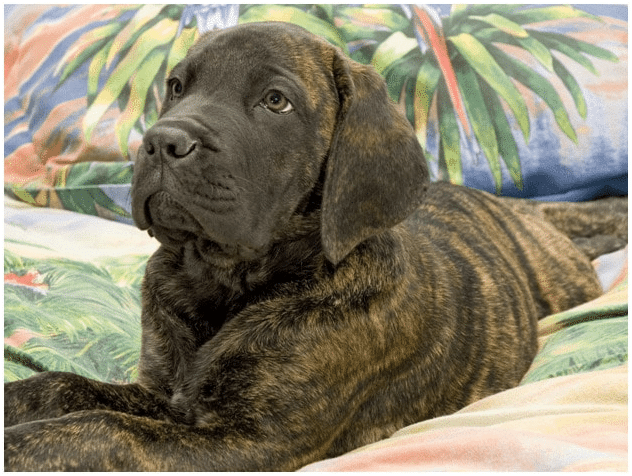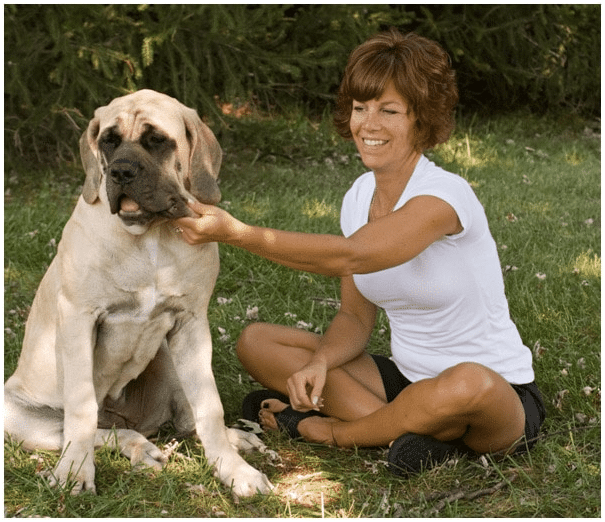Training an English Mastiff is important for their socialization and obedience. With their size and strength, early training is key to ensuring they are well-behaved and safe around others. So, how do you train an English Mastiff?
When it comes to training an English Mastiff, consistency and gentle reinforcement are the keys. They are eager to please but a bit more dominant than other dogs, so you must give constant leadership and guidance. As long as you make it clear who is in charge, you’ll have no issues!
It’s easy enough to say you need consistency in training, but what does that mean? Keep reading to learn everything you need to know about training your English Mastiff!
Why is it Important to Train Your English Mastiff?
If English Mastiffs are as gentle and loving as they say, why is it important to train them? The truth is that the loving and protective nature of this giant breed often manifests in guardianship. They want to protect you from any threats – but sometimes these threats are simple things like a squirrel or a delivery driver.
Knowing how to train your English Mastiff is crucial due to their protective nature, stubborn streak, and massive size. All of these elements are imposing and pose a large threat to strangers and unwanted guests.
Did you know that a fully mature male English Mastiff can weigh as much as 200 pounds? They are on record as the largest breed of dog. That’s right!
As you can see, training is essential to make sure your pup knows right from wrong and listens to your commands. You will have a well-behaved gentle giant with good training and socialization who will be the perfect companion.
Start Training Your Mastiff from a Young Age

As with most dogs, you should begin training your English Mastiff as soon as they come home. This means as soon as you bring your puppy home from a breeder or adoption shelter for most owners.
Typically, English Mastiffs can go home between 8-10 weeks, during which training should begin.
Mastiff puppies are easier to train for several reasons: they have not yet learned any destructive behaviors, are more likely to obey commands, and are small enough to be controlled easily in case of an emergency.
Imagine trying to rein in a fully grown English Mastiff as opposed to a little puppy. This is why you should train them as young as possible.
Let’s say you adopted or rescued an older Mastiff. Training will most likely be a bit harder because your dog will have to “unlearn” some behaviors. Starting as soon as possible is the best approach.
Why is Socializing Your Mastiff Essential?
Socialization is an essential part of training your English Mastiff. These dogs are born to be guardians and are excellent at protection.
However, this also means you may experience mastiff aggression from time to time if they perceive anything as a threat. Most new and unfamiliar things will fall under this category.
For example, I know many dogs who hate people on bicycles. This is usually because they have never seen a bicycle before and are scared, causing them to bark and chase the rider.
“If a dog is socialized early on to recognize that bicycles are not dangerous, walking in the park will become much smoother.“
There are many tips and training guides available to start the socialization process. The earlier you begin and the more you introduce your puppy to different things, the easier life will be!
The Key Elements of Training Your Mastiff
Now you know how important it is to begin training and stay on top of it! Next, it is essential to be informed about the critical elements of training to ensure the right approach.
Many people only know about training a dog in theory but are confused when it comes time to do it. Here are the main areas you should focus on when it comes to training your Mastiff!
Potty training
This will probably be the first area of training you work on, and for a good reason! Teaching your dog to go outside and to a designated area to potty is extremely important. You can begin potty training as soon as you bring your Mastiff home!
At first, try bringing them outside every thirty minutes. Wait outside for a few minutes, and reward them with a yummy treat and praise when they use the bathroom. Repeat this until your Mastiff learns to alert you or head outside immediately when it’s time to potty.
Leash training
Remember when I told you that a fully mature male Mastiff could weigh almost 200 pounds? This is something you should remember when it comes to leash training.
Teaching your Mastiff not to pull on the leash and to listen to your command to heel is essential; most of us can’t easily hold back 200 pounds of muscle wanting to run somewhere!
You can use positive and negative reinforcement in leash training. Reward good behavior such as heeling and not running ahead with lots of treats and affection.
Punish lousy behavior like pulling on the leash with a scolding and a lack of attention. In addition, make sure your Mastiff gets used to wearing a leash as soon as possible.
Behavior training / Obedience training
English Mastiffs are known to be gentle giants, great with children, and excellent family dogs. There is one exception to this – a threat to the people they love. If your Mastiff feels the need to protect you, aggressive behavior such as growling or showing teeth will happen immediately.
If your Mastiff shows aggression towards people or other dogs, make sure to remove them from the perceived threat as quickly as possible. Calm them down and reward them with a treat once they have become calm. Turn this into a positive experience where they connect good behavior with a positive outcome.
Other inappropriate behavior can also include excessive barking, chewing, and jumping.
“As with any dog, these behaviors should be corrected early on to prevent them from becoming ingrained habits.“
Start with basic obedience commands such as sit, stay, come, and down. As your English Mastiff masters these commands, you will be able to better train them on specific behaviors. Remember to remain patient and consistent throughout the training process.
Like all dogs, English Mastiffs respond best to positive reinforcement in the form of treats, praise, and petting.
Now you know the basics of training your English Mastiff! Training is an important part of dog ownership, and it is essential to begin early and be consistent.
Other Key Factors for Successful Training of Your Mastiff

Elements like potty training and preventing aggression are essential when it comes to training your Mastiff. However, these are not the only factors that need to be considered. Approaching training from the wrong angle can do more harm than good.
Luckily for you, we have other important factors to keep in mind to train your English Mastiff successfully. Keep reading to find out more!
Keep Training Short
No matter how intelligent a dog is, it cannot focus on one thing for an extended period. This is especially true for puppies!
When training your Mastiff in any factor, keep your sessions shorter than 15 minutes. This helps your dog learn what is needed without forgetting due to being overwhelmed with information.
While training should be short, it must also happen often! Dogs need short lessons usually cover the same topics to learn the correct behavior. This leads us right to our next point:
Be Consistent with Training Sessions
Keep the individual sessions short, but make sure training happens often. To train your dog to go outside to potty or come when called, you must consistently use the same training method until recognition emerges.
It would help if you were consistent with the behaviors that you want to enforce. If you don’t reward your dog every time they go outside at the start of training, they will not be motivated to learn.
Likewise, ignoring bad behavior sometimes but punishing it at others can lead to confusion.
Focus on Positive Reinforcement
Positive reinforcement is one of the best ways to train your puppy. Positive reinforcement relies on rewarding the behavior you want to see.
For example, you can teach your Mastiff to sit on command by rewarding them with high-value treats each time. They will find this experience helpful, and eventually, associate the behavior (sitting) with the reward (a treat).
Negative reinforcement can be used, but a physical punishment or even resorting to yelling can damage your relationship with your pup. Focus on positive reinforcement, which is very effective.
Ensure Plenty of Exercise
Exercise is essential for dogs. A dog that is not adequately exercised will often be too hyperactive or unhealthy to be trained. For English Mastiffs, it is recommended that they get at least 1 hour of exercise per day. This could be a walk, a game of fetch, or just playing around the house.
Exercise can also be a reward for training done well! A walk or a game of fetch are excellent rewards for your dog.
By making sure your Mastiff gets enough exercise, you are promoting a healthy life and making them easier to train all at the same time! By providing adequate regular exercise, your dog will burn any excess energy and likely develop an ideal temperament.
Just be sure to provide ample amounts of water during and after exercise.
Final thoughts
Without a doubt, English Mastiffs are an excellent companion. They are loyal, protective, and loving, all wrapped up in one big package.
Begin to train your English Mastiff as soon as they come home, to enforce good behaviors before they grow up. Be consistent and use positive reinforcement, and you will soon have a well-behaved family pet you can bring anywhere!


